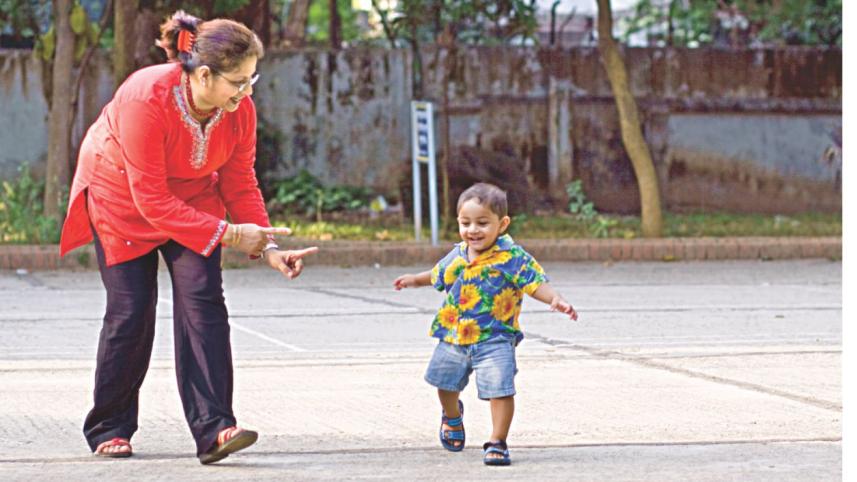Learning to Walk

Learning to walk is a major achievement for babies and parents and consequently can be a very anxious period of time for the parents. To ease these parental anxieties, we have rounded up a few ways you can recognise when your child is ready to walk and how to encourage them when this wonderful time comes.
When?
So when will your baby start taking those tiny steps? On an average, babies take their first steps around their first birthday. However, the age range at which a child may first start to walk varies widely from 9 to 18 months. Not every child learns to walk in the same age or even in the same way. In fact, some kids go straight from standing to walking, without crawling at all! It is important to accept these little quirks in the child's development. However, what's more important is to make sure that your child is using his or her arms and legs together. It is also vital to look at your child's progress.

Make sure that he is doing more this month than the last and is getting a bit more of his body off of the ground. If that is the case, you have no reason to worry. However, if he does not make any effort to move around even by the end of his first year, you should consult your doctor.

To encourage walking
Here are a few steps to help aid your child in taking those first independent footsteps:
Tummy time
Strong back muscles are essential for walking. Babies develop these by lifting their heads while lying on their stomachs. So make sure that from an early age, even just a few weeks after birth, your babies spend 30 minutes a day on the tummy. This practice also helps develop a baby's coordination.
Once your baby can sit
Help him cultivate balance and mobility by rolling a ball back and forth with him. Or hold a toy in front of her and slowly move it to one side, to encourage the baby to roll over. Motivate her to lunge or crawl with toys. By helping your child practice these will strengthen neck, legs and arms, and back of a baby. It also helps the baby gain control of his hips which will eventually be very helpful to your baby for pulling himself up to a standing position and safely sitting down without injuring himself.
Once S/he can stand
Your baby will soon start pulling herself up by all sorts of things, like furniture. To help your baby, let him walk in front of you slowly while you hold his hands. Periodically, let go of one hand, while keeping a firm grip on the other, so your baby can learn how to balance himself.
Alternatively, you can stand a few feet away from her and encourage her with lots of praises when she's standing on her own. Massage your babies' legs regularly to enhance development of leg muscles.
Once S/he starts moving around
Before long, your baby will start moving from wall to wall, chair to table, leaving her tiny handprints everywhere. Encourage her in this process by arranging sturdy furniture so she can use them as support as she moves around a room. If he cannot sit from a standing position, always be close so you can help ease his delicate body down with your hand to prevent injuries.
Childproofing
This may be a good time to childproof your home. Here are some steps to get you started:
Remove sharp corners reachable by your baby or cover them well.
Put away furniture which fall easily.
Minimise wires that your child may trip on. Put away rugs and stray things on floors e.g toys.
Supervise your baby whenever he is near or on the stairs.
Tape up plug points which your baby can reach.
Lock up all potentially harmful or toxic substances.

Should you buy a walker?
The American Academy of Pediatrics says no. They strongly discourage the use of walkers and say that walkers may not only hinder a baby's walking but are also extremely hazardous. Thousands of toddlers end up in hospital wards every year due to injuries from walkers. Also, Canada has already declared a ban on the sale of walkers.
Get the right footwear
Even though it is best to let your child walk barefoot indoors (this often prevents slipping) this can hardly be allowed outdoors. For the perfect fit:
Shop for shoes at the end of the day as feet grow about 5 percent by the end of the day.
When checking for fit, make the child stand. There should be a thumb-width gap between the tip of the shoe and the end of her toes and a pinkie width gap between the heel and the shoes.
Let him walk around the store and check that there are no irritations.
Buy a brand new pair every two to three months.
Finally, enjoy. You will never get these days with your beautiful baby ever again. Stop comparing him or her to other children; just because your colleague's kid has already started walking doesn't mean that your baby has to follow suit. Spend lots of quality time with your children and have tons of fun while helping your child to grow a little bit everyday.
By Maisha Rumelia Rahman
Model: Dhrubo, Nael



 For all latest news, follow The Daily Star's Google News channel.
For all latest news, follow The Daily Star's Google News channel.
Comments